Menu
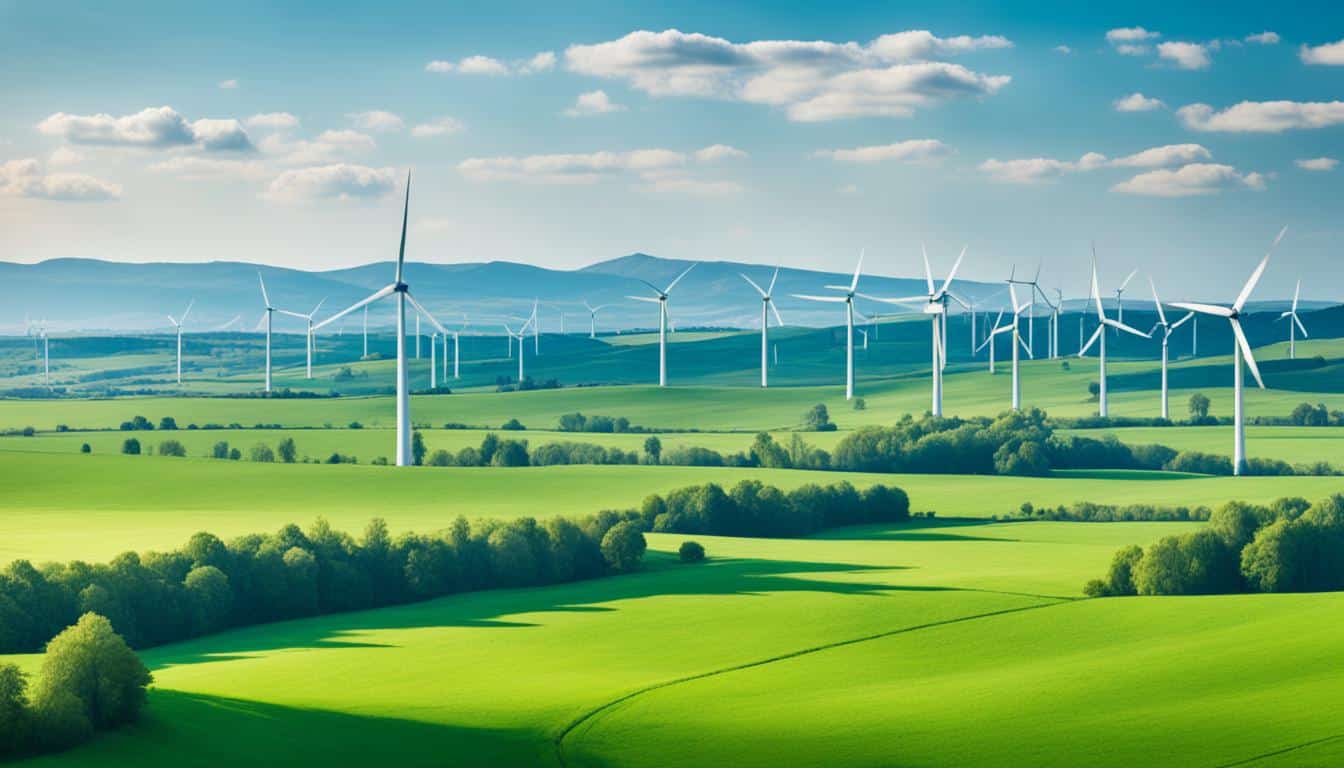
Did you know that unless we cut back, emissions from wealthy cities could double by 2050? They must be slashed by two-thirds before 2030. This fact shows how crucial it is to practice sustainable carbon habits now. It is up to both us as individuals and our communities to take part in carbon offsetting and green management. Otherwise, the future of our planet could be bleak.
Working out our carbon footprint means looking at our daily choices. What we eat, the things we buy, how we get around, and how far we travel all add up. They release greenhouse gases like carbon dioxide. These gases are making our planet warmer and causing climate changes.
It’s important to realise that our small actions can make a big difference together. For example, gardening with the seasons and picking plants that are right for your area helps in two ways. It reduces how far food has to travel, cutting down on emissions. Plus, you get to enjoy the food you’ve grown.
It’s key to know about your carbon footprint to take steps against climate change. This includes all the greenhouse gases like carbon dioxide and methane from what we do. To reduce your impact on the planet, you need to understand where your personal pollution is coming from.
A carbon footprint is the total of greenhouse gases from our daily lives. This involves things like how we get around, use energy, and eat. Eating habits, for example, make up a big part of how much carbon one family creates. The way food is produced and brought to us is also a big part of the problem.
Many things can raise or lower your carbon footprint:
Reducing your carbon footprint helps fight climate change’s worst effects. It can lessen droughts, wildfires, and higher sea levels. By being smart about what you do, you help save resources for the future and protect the earth.
Small changes at home can make a real difference. Things like better appliances and avoiding single-use plastics cut down on waste and pollution. This is good for the planet.
| Factor | Impact on Carbon Footprint |
|---|---|
| Transportation | 1.05 billion metric tons CO2e or 16.5% of total U.S. GHG emissions in 2021 |
| Residential Energy Use | 578.3 Mt CO2e in 2021, comprising 9.1% of total U.S. emissions |
| Food Production | 68% of food emissions from production; livestock methane emissions at 195 Mt CO2e |
| Waste Management | Effective recycling significantly reduces landfill waste and carbon footprint |
Adopting a sustainable lifestyle involves simple daily habits and long-term commitments. These changes help cut down on our environmental impact. They also make the planet healthier.
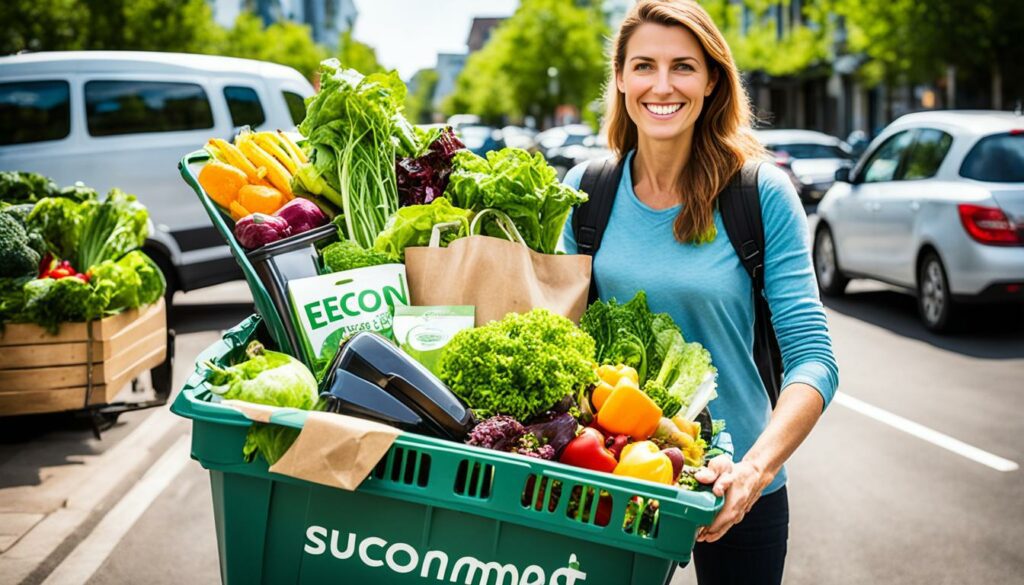
Making small changes in our daily lives can have a big effect. For example, we can cut back on plastic by using reusables like water bottles, coffee mugs, and bags. Not only is this good for the planet, but it also saves money.
Effective recycling and upcycling are also key daily habits. Instead of throwing things away, we can find new uses for them. This reduces waste and helps in creating a sustainable living space.
Long-term sustainable living means making bigger changes in how we live. Eating fewer animal products can greatly reduce our carbon footprint. Scientists say going vegetarian or vegan can cut it by 73%.
Buying food from local farmers helps too. It cuts down on emissions from food transport. Supporting carbon credit programs can offset our travel emissions, making our lifestyle even greener.
One vital step in caring for our planet is to significantly cut down reduction of plastic waste. The U.S. government is leading the way in this effort. On June 8, 2022, a clear goal was set. Secretary’s Order 3407 (SO 3407) plans to end the use of single-use plastic items on Department lands by 2032. This move impacts places like Yosemite National Park and the U.S. Fish and Wildlife Service.
By 2025, the Department wants to recycle or avoid wasting at least 50% of its trash. This target increases to 75% by 2030. Efforts at national parks such as Denali, Grand Teton, and Yosemite show how green choices are becoming key. The progress is happening at various levels, including plans by the Bureau of Land Management to cut single-use plastic waste. They aim for a full stop on these plastics by 2032.
Yosemite is leading by example. They stopped selling single-use plastic drink holders in 2022. This move encourages the use of reusable water bottles. The U.S. Fish and Wildlife Service is also making a difference. They want to stop selling single-use plastic bottles in 25% of their visitor centres by the end of 2024. These steps are big in the fight to lower sustainable business emissions and put a stop to plastic harm.
Here’s a quick look at what U.S. federal agencies and parks are doing to fight single-use plastics:
| Initiative | Agency | Target | Timeline |
|---|---|---|---|
| Eliminate Single-Use Plastic Products | All Department-managed lands | Complete phase-out | By 2032 |
| Eliminate Single-Use Plastic Beverage Containers | Yosemite National Park | Promote Reusable Water Bottles | Effective 2022 |
| Reduce Single-Use Plastic Bottles | FWS | Eliminate in 25% of visitor centres | By end of 2024 |
| Diversion Rates for Waste | The Department | 50% by 2025, 75% by 2030 | By 2025 and 2030 |
| Service-wide Policies on Single-Use Plastics | NPS | Reduce use across all services | Ongoing projects |
| Reduce Single-Use Plastic Policies | Bureau of Land Management | Complete elimination | By FY2032 |
| Incorporate Sustainable Operations | USGS | Reduction of Single-Use Plastic Products | Acquisition and grants policies |
These actions are making a big difference. They show a sharp drop in plastic waste and the success of choosing green options. Everyone’s small choices add up to a big, positive effect on our planet.
As more people care about the planet, learning effective recycling and upcycling is key. This helps cut down waste and boosts eco-friendly ideas. Both recycling and upcycling help reduce waste and manage it well, each in their own way.
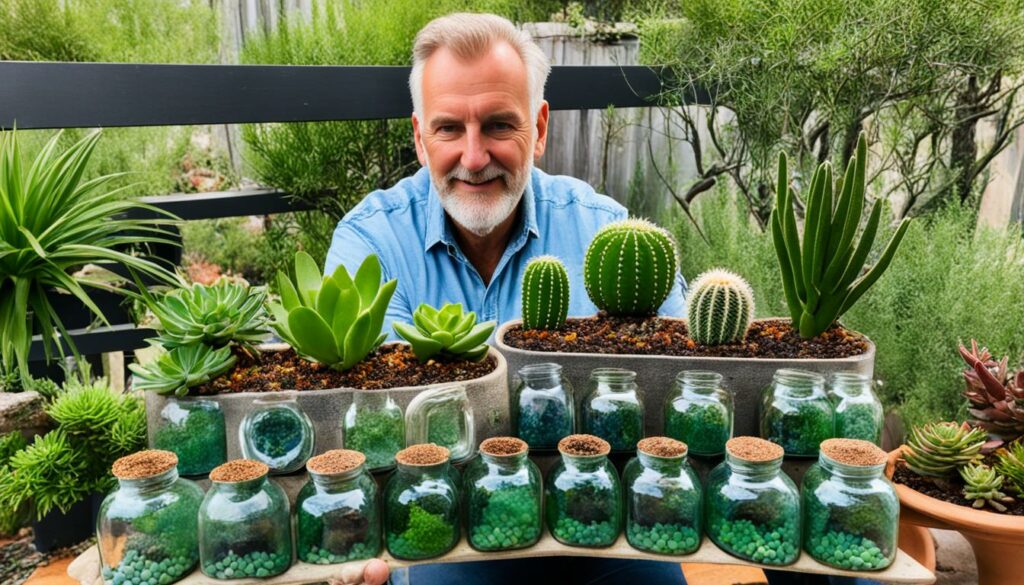
Recycling means turning old stuff into new things. It’s important to know the rules for recycling locally. Things like aluminium and glass are great for recycling, cutting down on waste. The U.S. Department of Agriculture says we waste 30-40% of our food. That’s why it’s vital to recycle food scraps by composting.
Recycling clothes and paper also saves resources. It cuts down on the gases that harm the environment, too.
Upcycling gives old items new uses, saving resources and limiting waste. For instance, you could make cleaning rags from old T-shirts. Or start plants in used plastic pots. Unlike recycling, upcycling keeps the original item’s form but adds a new use to it. A study in Food and Nutrition Sciences found that only 10% of people knew about upcycling at first. But 80% were ready to do it after they learned more.
Focusing on using energy well can help a lot. Plus, apps like Earth5R encourage people to try fun upcycling projects. This builds a strong commitment to looking after our planet.
The key to sustainable food practices is reducing waste. Each year, we lose a third of all the food made worldwide. This adds up to over 1 billion tonnes. Not using this food well also helps create 8%-10% of the world’s pollution.
It’s essential to deal with food waste from start to finish. From making the list at the shop, to dealing with leftovers, every step counts.
To cut food waste, start by shopping smart. Plan your meals, make a list, and be sure to stick to it. Over 40% of fresh food like fruits and veggies goes to waste each year.
When we only buy what we need, our fridges don’t fill up with food that rots. This also helps the environment by not needing so much food to be grown and moved around. It’s a win for waste reduction and lowering our carbon footprint.
Composting at home turns food scraps into great soil. This soil can be used to grow new food. It’s a big help in being more sustainable. Reducing food waste at home is also great for lessening our impact on the Earth.
By composting, we stop food from making harmful gases in landfills. This makes us part of the solution to a big environmental problem. And we save money and help the planet for the long run.
| Issue | Impact | Potential Savings |
|---|---|---|
| Global Food Waste | 8%-10% of GHG Emissions | $1 Trillion Annually |
| Consumer Food Waste | 25% of Food Supply | $120-$300 Billion Yearly |
| Household Reduction | Methane Emissions Reduction | $1,800 per US Family Annually |
It’s key to save energy at home to reduce our impact on the planet. By adopting simple steps, we can cut our energy use and lower our bills. This includes doing a DIY audit, using smart technology, and getting energy-saving appliances.
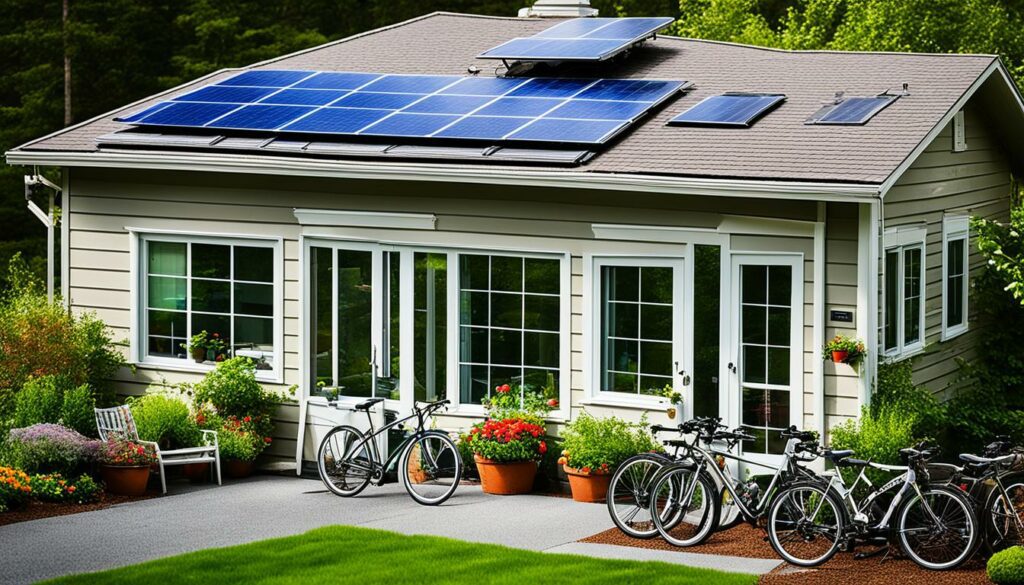
Checking your home for energy leaks is simple and can save you money. Look for drafts by windows and doors, check attic insulation, and your HVAC system’s performance. A good check-up can help you improve, saving up to 20% on heating and cooling.
Smart thermostats offer big savings by controlling temperatures better. They can adjust to your schedule to avoid waste. Using one can cut your energy bill by 16.5%, showing their value in saving energy.
Swapping old appliances for ENERGY STAR ones can make a large difference. These models use much less energy, saving you £11,000 over their life. Going for efficient lighting, like LEDs, can save about £70 a year and reduce greenhouse gases by 75%.
| Energy Conservation Method | Potential Savings |
|---|---|
| DIY Energy Audit | Up to 20% on heating and cooling costs |
| Smart Thermostats | 16.5% reduction in energy usage |
| Energy-Efficient Appliances | $11,000 lifetime savings |
| LED Bulbs | $70 annually |
By using smart tech and efficient appliances, we can make our homes more energy savvy. This leads to better energy use and saves us money.
Water conservation is vital for sustainable living. By using simple water conservation methods, we cut down on water wastage. This helps create a more sustainable future.
There are many easy ways to save water. We need to understand these and make them part of our daily routines.
Start saving water at home with eco-friendly practices. Turn off taps when not in use, like while brushing teeth. This simple act can save a lot of water.
Don’t let the tap run to get cold water. Instead, keep a bottle of water in the fridge. Doing this can stop up to 10 litres of water from going to waste every day.
In the garden, use a watering can instead of a hose. This controls water use and cuts down on how much you use. Avoid using sprinklers too often. They can use up to 1,000 litres of water in an hour. Use them only when necessary.
Using sustainable water management offers more than just water savings. Here are some extra benefits:
Adding one percentage point in organic matter to soil can increase its water storage by 27,000 gallons per acre.
Using 3.2 million tons of compost in California yearly can raise soil’s water-holding capacity by 3.7 billion gallons.
In California, water use for energy makes up a big part of the state’s resources. It eats up 19 percent of its electricity, 30 percent of its gas, and 88 billion gallons of diesel yearly.
These stats show why water conservation methods are crucial. They ensure we use energy efficiently and sustain the environment.
Choosing eco-friendly ways to travel is key to fighting climate change and lowering greenhouse gases. This part talks about why low-carbon travel, supporting carbon offset schemes, and sustainable tourism are important.

Carpooling cuts down the carbon emissions from daily drives and trips. Sharing rides not only saves money on fuel but also lowers the number of cars on the road. This reduces pollution. It’s a simple way to be eco-friendly. Carpooling also helps you make friends and build a travel community.
Using buses and trains is a big step towards low-carbon travel. Public transport is more eco-friendly than using your own car or flying. It reduces air pollution and eases traffic. Because they carry lots of people, buses and trains have a lower carbon footprint per person. This supports sustainable travel by decreasing individual emissions.
Sometimes, we have to take high-carbon trips like flights. But, we can balance this out by joining carbon offset schemes. These let us invest in green projects, like planting trees or renewable energy, to make up for the pollution. By doing this, we help the planet and chip in for a cleaner future. The Gold Standard and VCS are trusted by travellers for carbon offset schemes.
To travel in an eco-friendly way, we must be mindful and committed. Choosing green transport and offsetting our travel emissions are crucial. These decisions help lessen our impact on the environment.
Switching to sustainable cleaning products helps cut down on environmental harm. Many regular cleaners have harmful chemicals. These can lead to skin problems, allergies, and other health issues. By using *non-toxic products*, we lessen these risks.
Old-style cleaning products contain harmful substances. These can get into water, hurting fish and plants. They often come in plastic, adding to the world’s plastic problems.
Companies that focus on environmentally friendly cleaning often sell products that use less plastic. This includes zero waste and refill options. Such choices can make a big difference in reducing plastic waste.
Going for *chemical-free cleaning* is good for the planet and healthwise. These products usually have ingredients that don’t harm the environment. They also help you save money, with some brands offering subscriptions and affordable refills.
Many of these brands not only work well but are also very sustainable. They have done a good job in preserving the environment.
It’s important to look at how these products are packaged. Sustainable companies use recycled materials. Many now offer shipping that doesn’t harm the environment.
Choosing non-toxic products can really help the planet. Some companies even plant trees with your purchase. This means you’re directly helping the earth.
By going for sustainable household items, you’re choosing a better future. It’s about keeping our homes and the planet clean and healthy for all.
It’s key to use methods that cut down on carbon. This helps reduce the harm caused by too much CO2 in the air. Since the Industrial Revolution, CO2 levels have jumped from 280 to 415 parts per million. This big carbon footprint means we need to act fast. To lower our emissions, we should turn to renewable energy and aim for zero net emissions.
To fight against carbon, we can do many things. Companies can make their own clean energy, buy green energy credits, or purchase eco-friendly power. All this is crucial, considering the world releases over 40 billion tons of CO2 every year. By supporting projects that cut emissions, companies can even make up for their carbon use.
Using the circular economy is also key in the battle against climate change. It means making less waste and using products for longer. This significantly reduces our carbon output. Businesses that sell eco-friendly products have seen a big growth in sales. Over five years, they grew 8% more than others. This shows the real impact of going green.
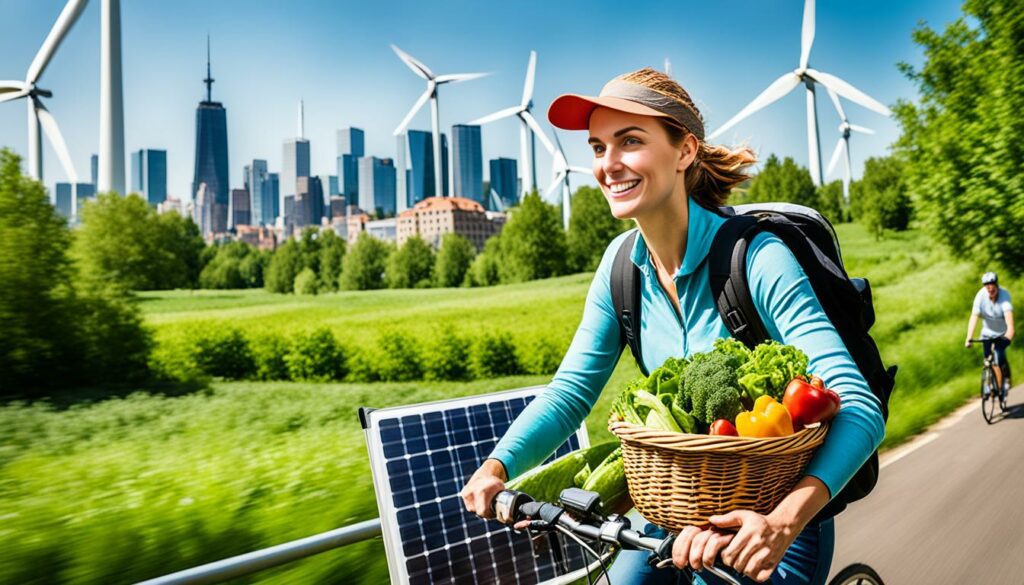
Looking at the good stories about fighting climate change shows us what works. To keep the planet from warming too much, we need to cut global CO2 emissions by 64% before 2030. It’s not just about using less carbon though. We also have to find ways to remove it from the air. More and more companies are promising to have zero emissions. Since 2019, the number of these companies has doubled. This shows that people are taking green carbon management more seriously.
By 2030, the world will need between 1.5 and 2.0 gigatons of carbon credit. And by 2050, this could be up to 13 gigatons. Tackling the issues in the Voluntary Carbon Market can help produce 8 to 12 gigatons yearly. This shows how important good carbon management is. It’s a crucial part of our plan to tackle climate change globally.
By choosing sustainable lighting for your home, you can lower energy use. LED technology is great for this. It cuts down on how much power you need. Plus, it helps reduce your electricity bills and your home’s carbon footprint.
LED bulbs are a top choice for saving energy and lasting a long time. They use 75% less power than old kinds of bulbs. And they can shine for up to 25 years. Almost all of the energy they get turns into light, not heat. This feature lowers the risk of fires. Also, they’re safe, as they don’t have mercury. LEDs work well with solar energy and other green sources too.
Changing to LEDs is easy and helps straight away. Here are some tips:
| Lighting Type | Energy Consumption | Lifespan | Heat Emission |
|---|---|---|---|
| Incandescent | High | 1,200 hours | High (wastes 95% of energy as heat) |
| Fluorescent | Moderate | 8,000 hours | Moderate (wastes 95% of energy as heat) |
| LED | Low (up to 80% less than incandescent) | 25,000-50,000 hours | Low (only 5% energy wasted as heat) |
Choosing LED lights benefits you and the planet. You save power, make your lights last longer, and cut down on hazards. It’s a simple way to be kind to both your wallet and the world.
Creating an eco-friendly home landscape needs a smart plan. We should use native plants and water-saving methods. These make your garden look good and help the planet.
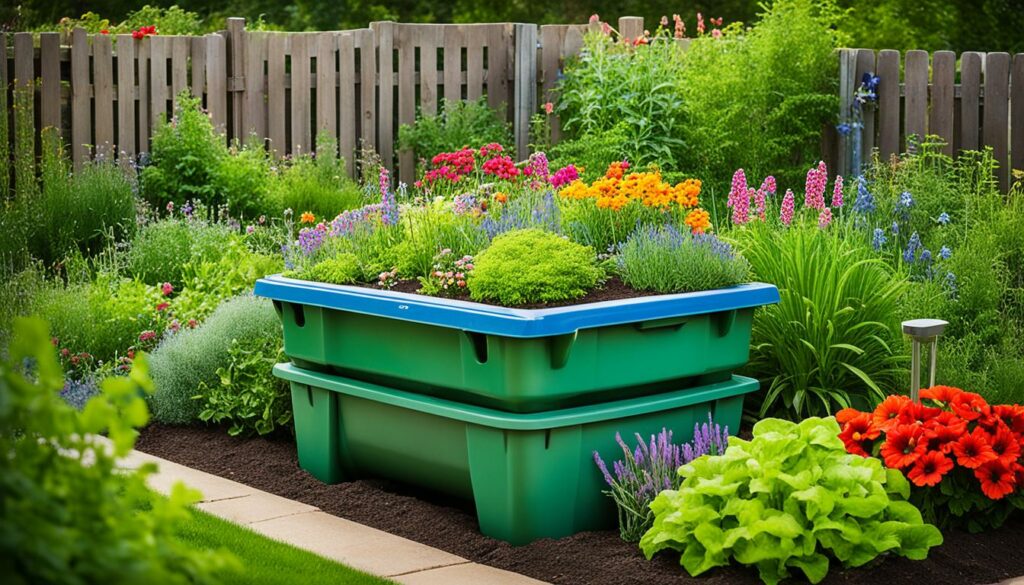
Choosing native plants is key for a green garden. They don’t need as much water or extra care. Native plants help save water and protect from soil erosion. They also help local wildlife.
By using local plants, you create a garden that fits naturally with the area. This is an eco-friendly choice that supports the ecosystem.
Saving water is very important for a sustainable garden. Since only 2.5% of the world’s water is fresh, we must be careful. Xeriscaping uses plants that need little water, which can cut water use in half.
| Technique | Water Savings | Benefits |
|---|---|---|
| Xeriscaping | Up to 50% | Drought-tolerant plants, reduces water usage |
| Rain Barrels | 30 gallons per 100 sq ft | Collects rainwater for reuse, reduces runoff |
| Permeable Pavers | High | Reduces flooding risk, allows rainwater infiltration |
Rain barrels gather water from your roof. They can store up to 1,000 gallons every year. Using materials like gravel lets rainwater soak into the ground. This keeps water in your garden and helps the earth.
Backing green companies helps our journey towards a green economy. Look for those that focus on clean energy, effective waste management, and care for the community. This way of shopping can push the whole market to go green.
When choosing green businesses, I first check their operations. Apple and 23 others are leading in using only renewable energy. Patagonia gives a lot back to help the planet.
It’s also important to see how they handle waste. Estée Lauder and Intel are great examples, with high recycling ratios. Google’s data centres stand out for wasting less energy and throwing out almost no trash.
Good companies teach staff about protecting the environment. They also offer chances to volunteer, which makes a big difference. This way, their good practices spread to everyone working there.
Supporting green businesses is good for the planet. When big names like Unilever work to emit less, our support helps them achieve it. We then all win by living in a cleaner world.
Choosing eco-products also sparks new green ideas. Companies like General Electric lead in clean tech. As they do more, other businesses notice and follow, creating a positive chain reaction.
Working for the environment means doing more than just recycling. It’s also about joining projects and sharing your thoughts on what should change. This way, you can help others care more and make real progress.
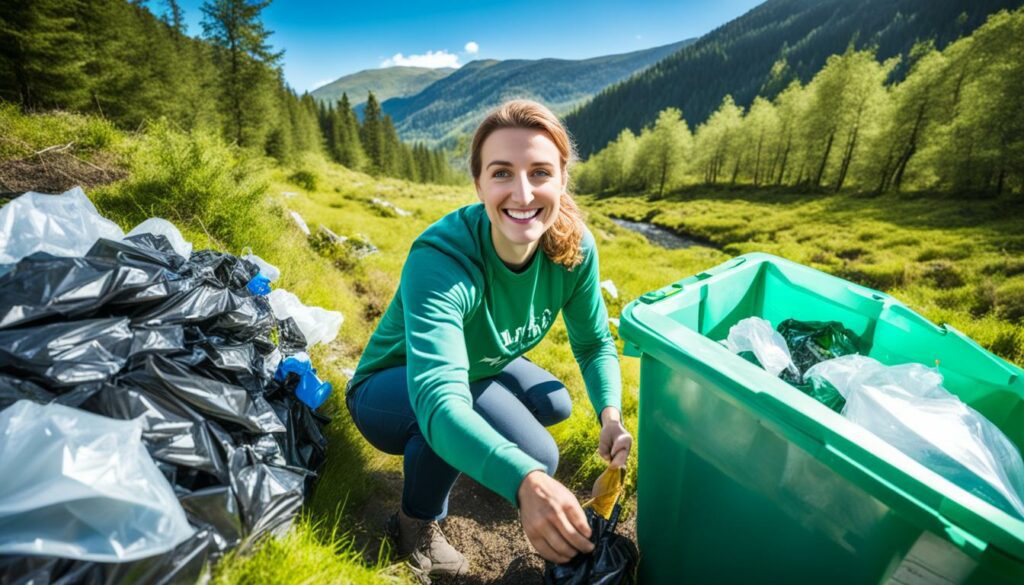
Joining local green projects is a big step in helping the planet. The U.S. made a lot of solid waste in 2018 – about five pounds per person every day. But by taking part in efforts like recycling, planting trees, and cleaning up, we can make a difference.
Even small things make a big impact. In 2018, every person in the U.S. used around 80-100 gallons of water daily. By choosing to use water carefully, we can help save this important resource.
| Initiative | Impact |
|---|---|
| Community Recycling Programmes | 69 million tons of waste recycled |
| Local Clean-Up Campaigns | 25 million tons composted |
| Water Conservation Workshops | Reduce daily water usage per household |
Speaking out can change environmental rules for the better. Industries like fashion and transportation cause a lot of pollution. By asking for rules that protect the planet, we can make a difference. This includes talking in meetings, signing petitions, and writing to leaders.
Food creation is a big source of pollution. Supporting plant-based diets and eco-friendly farming helps. Also, by pushing for more solar and wind energy, we can use cleaner power.
Helping the environment is key to making lasting changes. By taking part in local projects and talking about how we can do better, I can help make a difference.
It’s crucial to eat in a way that helps the planet. A mostly plant-based diet is great for this. It means eating less meat and choosing food that’s grown nearby.
Eating less meat really helps the environment. Beef and lamb produce lots of greenhouse gases. By eating more peas instead of beef, we can cut down on CO2 emissions. Even switching beef for chicken, fish, or plants for just a day helps the earth a lot.
Eating food from nearby boosts local farmers and cuts down on pollution from transport. While the transport of food is not the biggest pollution problem, foods like asparagus and berries flown in cause a lot of harm. Buying food from local farmer’s markets means fresher, healthier food and supports local businesses. This choice reduces the pollution from long-distance shipping.
| Diet Type | Emissions (kg CO2-eq per kg) |
|---|---|
| Beef | 60 |
| Lamb | 20+ |
| Peas | 1 |
| Cheese | 20+ |
| Chicken | 6 |
| Highly Perishable Foods (air-freighted) | Varies greatly |
Going more plant-based and eating local food help the earth. By choosing these, we lower the harm from meat and support a greener future.
Buying into renewable energy is more than a choice. It’s a pledge for a future that’s kind to the Earth. Too many of the world’s harmful gases come from using fossil fuels. This is why shifting to invest in renewable energy is so key. Even though about 29% of power comes from renewables, there’s room to grow.
There are lots of renewable sources to pick from. Wind, solar, and hydropower are the main players in clean energy. Wind power, for example, has seen huge growth from 1997 to 2018, increasing 75 times. Places like China and the U.S. are leading. In 2020, China made over half of the world’s new wind power setups.
Hydropower offers cheap electricity production. Then there’s geothermal energy, which taps into the Earth’s heat. Besides being clean, these options create way more jobs than the fossil fuel sector.
Solar power has great benefits for the planet and your pocket. The cost of solar electricity has dropped a massive 85% in a decade. This makes solar a strong contender for your money. Solar panels can cut a household’s carbon output by a whole tonne each year.
But there’s more good news: solar means jobs. By 2030, we could see 14 million new job spots in renewable energy. This would create 9 million more jobs around the world. It’s a big chance for worldwide economic growth and a cleaner future.
In sum, putting your money in renewables, like solar, pays off in lots of ways. We lessen our fossil fuel needs and help the economy with new jobs. Choosing renewable energy isn’t just smart; it’s the right thing to do for our planet’s future.
The world is changing fast, and we need to live more sustainably. Many countries have promised to reach carbon neutrality by 2050 or 2060. This shows how important it is to lower carbon emissions. The Earth now has more CO2 in its air than it did in 1850, leading to a 1.2°C increase in temperature. We must act quickly to make a difference.
We must move away from using up our planet’s limited fossil fuels. Experts say we only have a few decades left of these resources. This change could trigger a new era in how we live, one where being carbon neutral is very important. Tackling this issue will need big efforts from areas like farming, transport, and making things.
Using good data and joining forces across different fields is key. Experts from many areas, such as engineering and social studies, need to unite. They can then find the best ways to take CO2 out of the air. This work must be fair and help everyone. It aims not only to save our planet but also to strengthen communities. We must support green businesses and move towards using more renewable energy.
The choices we make today will shape our planet’s tomorrow. It’s up to us to cut down on harmful gases and choose cleaner ways of living. This will help fight climate change and leave a better world for those who come after us. It’s a big task, but by working together and starting now, we can make our future brighter.
A carbon footprint is the total amount of greenhouse gases we create. This comes from our daily actions. Things like how we travel, what energy we use, our food, and how we manage waste add to it.
Your carbon footprint gets bigger with different factors. These can be the way you travel, your energy use, what you eat, and how you handle waste. Each of these does its part in creating greenhouse gases.
Lowering your carbon footprint is key to fighting climate change. It also helps protect our land and sea. Making small changes, like using things again and eating less meat, can cut down on harmful gases.
An eco-friendly life starts with simple habits. Ditch single-use plastics. Always pick reusable options and recycle well. Doing this reduces waste and your environmental harm.
For lasting sustainable actions, go plant-based and pick local foods. Also, choose appliances that save energy. You can even offset your carbon use. These practices are good for the planet.
Switch to durable items like water bottles and bags instead of one-offs. By doing this, you help the planet and save money in the long run.
Good recycling means knowing what goes where and making sure it’s clean and dry. Follow your area’s rules to help the planet and use resources well.
tTurn old clothes into cleaning cloths or use old containers to grow plants. These clever ideas cut down on what we throw away and serve useful purposes.
Be smart when you shop and only get what you need. Compost food scraps. This stops food from being wasted and keeps the air cleaner.
Start with a home energy check. Then, use smart tech and energy-saving devices. This cuts down on energy use and supports green living.
Turn off water when you don’t need it, use a can instead of a hose, and fit low-flow shower heads. These steps save water, energy, and help the planet.
Public transport cuts down on your personal emissions and eases traffic. It’s a sustainable choice that keeps our planet and communities cleaner.
Neutralise your travel’s impact by supporting carbon offset projects. This helps balance out the harm you do and supports green plans.
Traditional cleaners can damage water and harm the planet. Go for natural or make your own to keep our homes and nature safe.
Picking green cleaners or homemade ones is safer and kinder to the planet. Look for natural ingredients like vinegar and baking soda.
LED bulbs last long and save heaps of energy. This means you use less power and produce fewer harmful gases, all while saving money.
Native plants are great for the world. They need less water, help local wildlife, and make your garden thrive. Plus, they leave a smaller water mark.
Find green companies by looking at their actions and seeing if they have eco-certifications. These businesses work to protect our planet’s future.
Join in by teaming up with local groups, offering your time, and pushing for greener rules. This helps make big changes in your own community.
Eating less meat lowers your carbon footprint. By choosing more plant-based foods, you use fewer resources. This is good for the Earth.
Solar power cuts back on fossil fuels, saving you money and making the air cleaner. There are also good deals to make it affordable.
Clean energy is key for a better future. It gets us off harmful fuels, cuts emissions, and helps us live in a way that lasts.